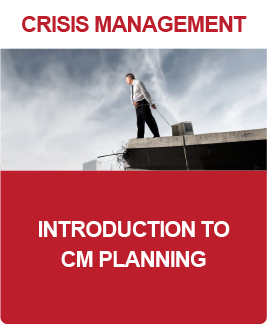Part 1: Introduction to CM Planning
 Threats/Crisis Scenarios
Threats/Crisis Scenarios
The first component of the CM Plan is the Threats/Crisis Scenario component. In this section, participants will list down the list of threats and crisis scenarios that the CM Plan is intended to face.
For more information on the selection of threats and crisis scenarios in the Crisis Risk Assessment phase, read "What Type of Crisis or Crisis Scenario Should I Be Planning For My Organisation?"
The next section is Crisis Management Objectives. Under this section, participants are to list down the key objectives the organization wishes to achieve during and after a crisis.
-
Ensure the health, safety and welfare of staff and customers.
-
Control the immediate situation and continue business operations with minimum disruption.
-
Restore the business to normality as quickly as possible.
-
Minimize loss or damage and maintain business confidence.
-
Maintain effective communications internally and with customers, the media and regulatory bodies.
Response to Emergencies
The Response to Emergencies section of the CM Plan highlights the procedure for how an Emergency is initially responded to immediately after it happens. It highlights who is the main candidate responsible for activating the CM Plan in the event of a Crisis, who else is able to activate in lieu of his absence, and who are to tell them in the event of an emergency.
The Crisis Management Team (CMT) section highlights the following sub-sections of information
-
The staff roles in the CMT (Chief Executive Officer, Chief Financial Officer)
-
Secondary staff roles that are not part of the main CMT but may be co-opted in depending on the emergency (Head of Human Resources, Head of Audit.)
-
The responsibilities of the CMT in the event of an emergency or crisis
The incident Management Team (IMT) section highlights the following sub-sections of information
-
The staff roles in the IMT (IT Manager, Head of Admin, Team Coordinators)
-
The roles and responsibilities of the IMT
-
The Plan Activation procedure
-
A list of general considerations for the types of crisis scenarios that would activate the plan or demand immediate response from the IMT
The External contact and Communication section highlights the best practices on staff communication within the company, with media, and with other public stakeholders. While not stored within this document itself, it will also highlight the need for the respective IMT managers to keep updated contact lists on all key contacts (Inside or outside the company)
The Preparation (IMT) section involves pre-crisis preparations performed by the IMT prior to any emergency or crisis happening. it highlights the following sub-sections of information:
-
Risk Control (The reduction of risk through compliance with company policies and standards)
-
Planning (The production, update, and assessment of the CM Plan)
-
Threat Monitoring (The monitoring of environmental threats by the assigned coordinators and the monitoring of business threats by their respective business head)
-
Training and Evaluation (The development of a training programme to educate staff on their roles in the Crisis Management plan)




